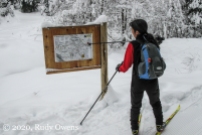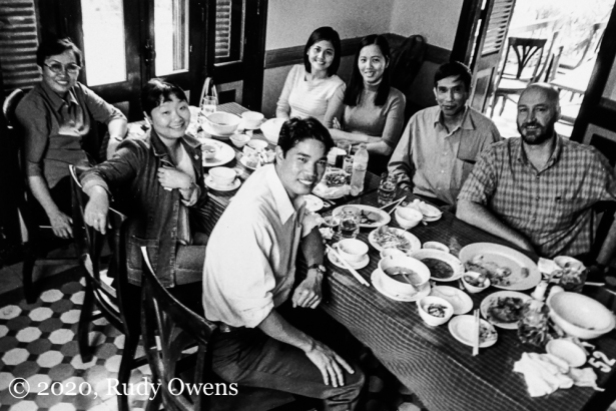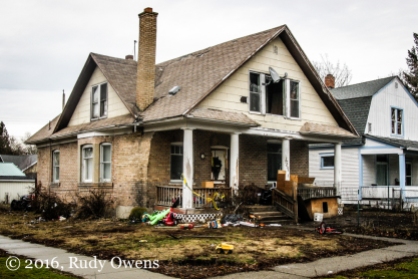(Click on each photo to see a larger picture on a separate picture page.)
I became a passionate cross-country skier mostly because I had the good fortune of living in Anchorage from 2004 through 2010. There I was blessed with a fabulous and publicly-owned set of multi-use trails and trail systems in parks. I could ski sometimes nearly six months a year, depending on when the first snows came and when the last snows melted.
I mostly remember skiing being very accessible to nearly everyone because the trails were close to home and because gear was not too expensive for the basic set up of boots, poles, bindings, and skis. You could even get used equipment.
The local group promoting the sport and maintaining the trails, the non-profit Nordic Skiing Association of Anchorage, was committed to youth inclusion for all residents. That meant all young people, regardless of race.
When I lived there, Anchorage was more diverse than many outside of Alaska think, with about 65 percent of the residents who identified as white and 35 percent being non-whites, with the largest group being Alaska Natives. Some of that diversity could be seen in the faces of the young skiers competing for the high school teams and on the trails. But even then, in this very democratic and outdoor-oriented place, the faces I saw skiing were like me—white.
However, cross-country skiing in Anchorage is not like cross-country skiing in the rest of the United States. Today the almost entire lack of diversity of this sport nationally remains cross-country skiing’s great Achilles’ heel. That reality is not addressed with the type of debate that is needed.
In my view, everyone who does this sport, either Nordic or single-track style, knows this racial breakdown whenever they ski. If they do not, they are willfully fooling themselves from the facts before their eyes every time they clip into their skis and head out on trails in recreation areas that remain almost exclusively the domain of white Americans.
Race and country-skiing are mostly taboo topics in the multimedia world dedicated to the sport and those who do it. However I found one recent article on the racial divide in this sport I still love on the FasterSkier website. Refreshingly, it confronted the basic facts about the folks who do the sport and the factors contributing to its glaring and overwhelming whiteness.

Skier and writer Ben Theyerl wrote in an article published in August 2020: “The demographics of where the places that harbor Nordic ski communities are on a map allows this statistic to go unchecked. The trail networks linked to small rural towns and resorts that are historically, and presently, white, shelter us from having to confront and come to terms with our sport’s lack of racial diversity. So do the images of our heritage as a Nordic community, and of what it looks like to be an elite Nordic athlete. … We can choose as a community to stay on this sheltered path, or we can take the road less travelled for the Nordic community to finally discuss the overwhelming whiteness of our sport and the places that we do it in.”
Cross-Country skiing in Washington and the Methow Valley

As a former resident of Washington state in the late 1980s and early 1990s, and then again through 2004, and finally 2010 to 2014, I have cross country skied there during the winters of my now former state. My adventures over these years took me at different times to the scenic Methow Valley, in Okanogan County, just south of the Canadian border and west of the Cascade Mountains.
Once an area that had homesteads and ranches on former Native American lands, it is now dotted with second and third homes of the upper middle class, the wealthy, and also the extremely wealthy—many from the Seattle area.
Since my first visit in late 1987 to this past weekend, I have seen it transform into a year-round recreation area that promotes winter sports and cross-country skiing. The residents who live and have lived there famously developed a wonderful trail community during these decades. That is seen in the group called the Methow Valley Trail Association (MTVA), which is a non-profit organization that maintains the incredible network of classic and single-track trails, snowshoe trails, and now fat-tire bike trails.
According to the MTVA’s website, the volunteer-led group maintains “over 200 kilometers (that’s 120 miles) of cross-country ski trails in the winter months,” and that network “is recognized as one of the finest trail systems in North America for Nordic skiing, mountain biking, trail running and hiking.”
I would argue that the Methow Valley is, without question, one of the finest cross-country ski areas in North America thanks to its geography, plentiful and mostly predictable snowfall, and the good work of these volunteers and donors who support this form of recreation. The area, like so much of the United States, also has racial divisions that can be seen in where most of the county’s non-white residents call home.
According to the 2020 U.S. Census Bureau, Okanogan County had a population of 42,104 as of 2020. The sparsely populated and beautiful mountainous county includes the towns in the Methow Valley like Winthrop and Twisp and neighboring cities like Omak. The Census Bureau reported that the county is 64 percent white (non-Hispanic or non-Latino), followed next by Hispanic or Latino at 21 percent, and American Indian or Native Americans at 13 percent. The diversity from the two next largest groups can be found in communities closer to the Colville Reservation like Omak and towns like Pateros and Brewster, where agricultural work is plentiful and Latinos have long-settled because of farmwork-related employment opportunities like other communities in central Washington.
However, that diversity is not visible in the Methow Valley. During my recent three-day visit, I saw some visitors who I would identify as having Asian ancestry, but no one on any trail who was African American. Most of the skiers I saw on the gloriously groomed trails were white like me. It is a fact that one cannot ignore when enjoying the beauty of this great sport. This fact has not changed in the last 12 years since I began skiing there after returning to the Lower 48 from Alaska (as Alaskans refer to the lower states).
The Future in Washington’s wealthy, winter Shangri-La
As the ski community grew in the Methow Valley in the last two decades, so did the country’s income inequality gap. That gap has accelerated the concentration of wealth in the hands of an ever smaller number of richer Americans since the Great Recession, and more recently the pandemic.
That wealth concentration can be seen in patterns of land use in the Methow that are visible to any visitor who travels there. Those who can afford to purchase retirement homes and summer and winter second and third homes—mostly white and wealthy affluent out of towners—have chosen to settle in this area, with its spectacular vistas and abundant forms of recreation that cater almost entirely to white Americans.
Winthrop resident Solveig Torvik described this in her column from Aug. 4, 2021. “The Methow many of us so smugly assume is a model of a caring community with widespread civic engagement … reads instead much like a cautionary tale of a failed society,” she wrote. Torvik pointed to a study of the valley by a Washington State University sociology professor, Jennifer Sherman, who described the obvious divisions: “The Methow Valley is a deeply divided community where wealthy urbanites ‘blind’ to their privilege ‘hoard’ their social capital while impoverished, excluded, resentful rural old-timers struggle to survive.”

According to an Oct. 7, 2020 story in the local newspaper called The Methow Valley News, a virtual “COVID land rush” is underway, fueled also by the pandemic: “One thing it means is a dramatic increase in median home prices in the Methow Valley. The median home price in September this year was $440,000, compared to $329,000 in September last year and $312,000 in 2018, based on statistics [broker Anne] Eckmann compiled from the Northwest Multiple Listing Service. In mid-September, there were 34 homes available for sale in the Methow Valley — 10 of them priced under $350,000 and eight priced over $1 million, Eckmann said.”
This is not that different than other winter resort areas in the country in Montana, Colorado, Utah, and Vermont. What’s different now is how visibly those new, rich residents have settled in the last 15 years in the Methow Valley, particularly around the town of Winthrop. I have seen that change since I first Nordic skied here in 2010 when I moved back to Seattle, and then visited a friend who lives near Winthrop. It had been eight years since I was last there in February 2014.
Battles over future comprehensive planning in the county and water rights remain active, with many newcomers seeking access to the limited water resources and groups seeking to manage and plan for future growth. Growing threats from climate change and wildfire also have further exacerbated debates over growth tied to the desires of the wealthy to live in the fire-prone wildland urban interface, in places like the Methow Valley. The battles will likely continue there, similar to conflicts in communities in the West that have confronted the old maxim that “water flowing uphill to money.”
I do not know when I will travel to the Methow Valley again. It is a 400-mile journey by car from my home in Portland.
I took this trip to take a needed break from my work on Oregon’s pandemic response. I needed a recharge, and Nordic skiing is one way I can do that. It worked, too.
I enjoyed my stay with a longtime friend who moved there years earlier, who shared with me the struggles she is seeing as a resident over development there. In the end, I am left with almost magical memories of groomed trails, snow-covered mountain peaks, and the ongoing awareness that this sport that I once did daily on a community trail in urban Anchorage is still not widely shared by many.










































